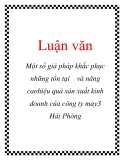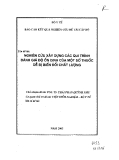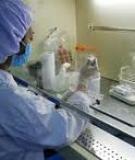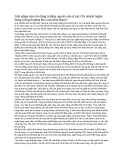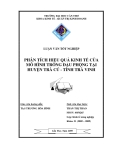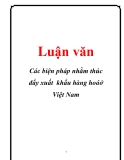J. Vet. Sci. (2004),(cid:1)5(1), 49–58
(cid:1) (cid:2) (cid:3) (cid:4) (cid:5) (cid:6) (cid:7) (cid:8) (cid:2) (cid:9) (cid:10)(cid:11)(cid:12)(cid:11)(cid:13)(cid:14)(cid:15)(cid:16)(cid:13)(cid:17)(cid:8) (cid:18)(cid:19)(cid:14)(cid:11)(cid:15)(cid:19)(cid:11)
The effects of cyclophosphamide treatment on the pathogenesis of subgroup J avian leukosis virus (ALV-J) infection in broiler chickens with Marek’s disease virus exposure
Yongbaek Kim*, Thomas P. Brown and Mary J. Pantin-Jackwood
Departments of Veterinary Pathology and Avian Medicine, College of Veterinary Medicine, University of Georgia, Athens, GA 30602, USA
Introduction
(CY)
Cyclophosphamide
treat
to
the
is an antineoplastic and immunomodulating agent used tumors and autoimmune disorders. Newly hatched chickens treated with CY are rendered irreversibly B cell deficient [16,17]. Cyclophosphamide treatments have been used to inhibit humoral immunity in order to determine its role in the pathogenesis of infectious pathogens of chickens [1,25].
In 1988, an exogenous avian leukosis virus (ALV) belonging to a new subgroup for chickens was isolated from meat-type chicken lines and designated as subgroup J [19]. Subgroup J ALV (ALV-J) induces tumors and decreased weight gain in experimentally or naturally infected chickens [22,23,32]. Like all other exogenous ALVs, transmission of ALV-J occurs either by vertical or horizontal infection. In vertical transmission, chicks become immunologically tolerant to the virus and are persistently viremic. Those chickens will remain viremic, will shed virus, and are more likely to develop tumors. While horizontal infection with other ALV subgroups often leads to immune non-shedders, the consequences of similar infections with ALV-J can vary between egg-type and meat-type birds. Infection of egg-type birds post-hatch leads to immune non-shedders. However, similar infection of meat-type birds can result in either tolerant viremic infections or transient viremia [20,21]. Since horizontal transmission of the ALV-J is more significant, eradication programs for this subgroup have to be applied more intensely [24].
Studies were performed to determine the effects of B- cell suppression on the pathogenesis of Subgroup J avian leukosis virus (ALV-J) in broiler chickens. Neonatal chickens were treated with cyclophosphamide (CY) or PBS, and then infected with ALV-J (ADOL-7501) at 2 weeks of age. CY treatment induced B cell specific experiment throughout immunosuppression confirmed by decreased bursal weight, intact lymphocyte mitogenetic activity stimulated by Con A and increased relative subpopulation of CD3-positive cells as measured by flow cytometry. Chickens in this experiment had Mareks disease virus exposure prior to three weeks of age as determined by the presence of lymphocytic infiltration and antibody. Virus neutralizing antibody against ALV-J was first observed at 6 weeks post-infection in some of the infected chickens in the PBS group. As expected, none of the chickens from the CY group and uninfected chickens developed virus-neutralizing antibody. The viremic status was measured by real time RT-PCR using SYBR green I dye. The percentage of viremic chickens was significantly higher, and more chickens had high titered viremia, in the CY treated group. No neoplastic foci consistent with ALV- J infection were observed in any of the experimental chickens. The frequency and intensity of viral antigen expression determined by immunohistochemistry was significantly higher in tissues from CY treated birds than those of PBS treated chickens at 3 weeks post-infection. This study showed that B cell specific immunosuppression with CY treatment in chickens resulted in increase in viremia and viral antigen load in tissues.
additional agents,
factors concurrent
Key words: Avian leukosis virus subgroup J, cyclophospha- mide, B-cell, real time RT-PCR, chickens
*Corresponding author Phone: 1-919-316-4559; Fax: 1-919-541-4714 E-mail: kim16@niehs.nih.gov
Mortality in flocks with ALV-J varies widely, suggesting such as involvement of infections, immunosuppressive vaccination against other diseases and husbandry practices in the manifestation of the disease. This study was performed to determine the effects of suppression of humoral immunity on the pathogenesis of ALV-J infection in the broiler chickens.
50
Yongbaek Kim et al.
Materials and Methods
Chickens
White Plymouth Rock eggs (SEPRL, USDA, Athens, GA, USA) were obtained from a flock that was free of avian leukosis viruses and other common poultry diseases. Chickens were hatched and reared on wire-floored isolation units until 2 weeks of age, then transferred to plastic isolation units. Feed and water were provided ad libitum.
Virus
ADOL-7501 isolate of ALV-J (ADOL, East Lansing, MI) was cloned by three limiting dilutions in secondary line 0 chicken embryo fibroblast (CEF) cultures. This cloned virus had a tissue culture infective dose 50 (TCID50) of 106.5/ml. It was diluted with cell culture medium and 0.1 ml containing 104.5 TCID50 was inoculated into chickens intraperitoneally. A virus neutralization (VN) test was carried out on secondary line 0 chicken embryo fibroblast (CEF) cultures as a microneutralization assay using 100 TCID50/well [10].
Experimental design
chickens from each group at necropsy. Spleens were collected individually in Hanks balanced salt solution (HBSS, Sigma, St. Louis, MO) and prepared as described previously with minor modifications [4]. Briefly, spleens were homogenized using a Tissue Tearor (Biospec Products Inc., Racine, WI) and splenocytes were resuspended in HBSS-CMF with 1% fetal bovine serum (FBS). Splenocytes were centrifuged over 3 ml Histopaque 1077 (Sigma, St. Louis, MO) for 30 minutes at 400 g. The recovered mononuclear cell fraction was washed and resuspended as described previously at 2.67 × 107 cells per ml (Coulter Counter® Model D2N automated cell counter, Coulter Corp., Hialeah, FL). For each chicken, 2 × 106 cells, Con A (Sigma, St. Louis, MO) at 10 µg/ml, and tritiated thymidine (NEN Life Science Products, Boston, MA) at 5 µCi/ml were added to a 96 well round bottom plate and incubated for 72 hours at 41oC as described previously [4]. For cell control wells, the cell media (RPMI 1640, Life technologies, Grand island, NY) was added instead of Con A. Test and control wells were run in triplicate for each chicken. Cells were harvested using a Skatron 11019 cell harvester (Skatron AS, Tranby, Norway) and radioactivity measured using a Beckman LS3801 liquid scintillation counter (Beckman Instruments, Irvine, CA) [27]. The radioactivity of the cells harvested onto filtermats was assayed on a scintillation counter (Beckman, USA) and recorded as counts per minutes (cpm). Stimulation index (SI) of each samples were calculated as follows: SI = [{(cpm of stimulated) − (cpm of unstimulated)}/(cpm of unstimulated)]
Flowcytometry
2 ml HBSS
FBS,
1%
Chicks (n = 140) were hatched from fertilized eggs (n = 170). The hatched chicks were divided into a PBS treated group (n = 45 chicks) and a CY treated group (n = 95 chicks). The latter received one intraperitoneal injection of (Cyclophosphamide monohydrate; Sigma 4 mg CY Chemical Co., St. Louis, MO) daily for 4 days from the first day after hatch. For injection, CY was obtained in a dry form, and an aqueous solution was prepared by reconstituting 1.6 g in 40 ml of calcium- and magnesium- free phosphate buffered saline (CMF-PBS) and filtering this through a 0.22-µm syringe filter. The resulting solution contained 40 mg of CY/ml. The PBS group received one intraperitoneal injection of 0.1 ml sterile CMF-PBS daily for 4 days from the first day after hatch. At 2 weeks of age, 38 chickens from each of the PBS and CY treated group were randomly selected. Groups were then subdivided into the following (n = 18), treatments: PBS without ALV-J PBS + ALV-J (n = 20), CY without ALV-J (n = 18), CY + ALV-J (n = 20). At 2 weeks of age, chickens were infected with an ALV-J isolate, ADOL-7501.
Splenocytes prepared as described above were suspended to a concentration of 1 × 107 cells/ml. Cells (1 × 106) were incubated with a mouse monoclonal antibody, chicken CD3- FITC (Southern Biotech, Birmingham, AL), for 1 hour at 4oC. Isotype controls (nonspecific mouse IgG labeled with FITC, Southern Biotech, Birmingham, AL) were used in each labeling series to identify the region of the histogram containing cells positive for surface antigen. After washing relative twice with immunofluorescence of cells was analyzed using a flow cytometer (EPICS Coulter Flowcytometer, Florida, USA). Analytical gates were chosen based on forward and side scatter to include lymphocytes and to exclude debris, dead cells, and red cells.
RNA extraction
sampled
for
At 3 days, 1, 3, 6 and 9 weeks post-infection, all chickens were bled to test their viremia and antibody status of ALV-J. At 3 days, 1, 3, 6, and 9 weeks post-infection, three to four chickens from each of the four groups were killed by cervical dislocation and lymphocyte blastogenesis assay, flow cytometry, and histopathology. Body weights and relative bursal weights were also measured at this time using the formula [Relative bursal weight = (bursal weight/body weight) × 1000].
Isolation of splenocytes and mitogenesis assay
Total RNAs were extracted from 250 µl of each of plasma samples collected at 0.3, 1, 3, 6 and 9 weeks post-infection using a commercial reagent and according to manufacturer’s recommendations (Tri Reagent BD, Molecular Research Center Inc. Cincinnati, OH). Each RNA sample was resuspended in 20 µl of diethyl pyrocarbonate (DEPC) treated water and stored at −80oC until use.
Approximately half of the spleen was harvested from
ALV-J and cyclophosphamide
51
Real time RT-PCR
stained with H&E and examined microscopically.
Immunohistochemistry (IHC)
Indianapolis,
All techniques were done at room temperature. Tissue sections were cut at 4 µm and mounted on charged glass slides (Superfrost/Plus, Fisher Scientific, Pittsburgh, PA). Paraffin was melted from the slides (10 minutes at 65oC) and removed by immersion in Hemo-De three times (5 minutes each time). Slides were air dried and digested with ready-to- use proteinase K (DAKO, Carpinteria, CA) for 5 minutes to expose antigenic target sites. IHC staining was performed in an automated stainer (Leica ST 5050, Nussloch, Germany) using a nonbiotin peroxidase kit (Dako Envision System, DAKO, Carpinteria, CA) according to the manufacturers recommendations. The primary antibody used was a monoclonal antibody specific for the gp85 envelope glycoprotein of ALV-J (provided by Dr. Lucy Lee, ADOL, East Lansing, MI). After IHC staining, sections were counter-stained with hematoxylin, air dried, cover slipped, and examined using light microscopy. Staining intensity and extent were converted to scores as previously described (2): 0 = negative; 1 = few positive cells; 2 = many positive cells.
Statistical analysis
RT-PCR was performed using reagents from the Light Cycler-RNA Amplification SYBR Green® I Kit (ROCHE Molecular Biochemicals, Indianapolis, IN). The primers used have been described and produced an amplicon of approximately 545 bp [30]. Amplification and detection of specific products was undertaken by a Light Cycler system (ROCHE Molecular Biochemicals, IN) according to the manufacturer’s recommendations (ROCHE Light Cycler version 3.0, ROCHE Molecular Biochemicals, Indianapolis, IN). Briefly, reverse transcription was done at 55oC for 10 minutes and denaturation was done at 95oC for 30 seconds. Forty PCR cycles were done with denaturation at 95oC, hybridization at 55oC for 10 seconds, and extension at 72oC for 13 seconds. The melting curve analysis was done with an initial denaturation at 95oC. DNA melting was accomplished with an initial temperature of 65oC for 10 seconds and a gradual temperature increase with a transition rate of 0.1 per seconds until reaching 95oC. The melting temperature of the expected 545 bp amplicon was estimated to be 83oC to 85oC, as determined using cell lysates infected with an ALV-J isolate and control RNA. This estimated melting temperature was used to confirm the identity of the products obtained using real time RT-PCR (ROCHE Molecular Biochemicals, Indianapolis, IN).
Quantitation of viral RNA
The body weight gain, relative bursal weight and data from mitogenesis assay and flow cytometry were analyzed using two-tailed Student t-test with assumption of different variance. Significance of differences in percentage of viremia, antibody and the results of histopathology was determined by Chi-square analysis, and mean tissue scores from immunohistochemistry were analyzed using Kruskal- Wallis analysis of variance. Significance was assumed at the 0.05 level of probability.
To quantitate the viral RNA in plasma, we used ten-fold
serial dilution of control RNA produced by in vitro
transcription as standard [14]. We performed real time RT-
PCR with RNAs from cell lysates with different TCID50s to
determine correlation between control RNA and TCID50s.
We divided the results from real time RT-PCR into three
categories: low (V<0.1 pg), medium (0.1
Results
Serology
Body weight, relative bursal weight and lymphocyte mitogenesis assay
The results of body weight, relative bursal weight and lymphocyte mitogenesis assay are summarized in Table 1. Body weights of the chickens treated with CY were significantly lower than those that were PBS treated. However, no significant difference was induced by the virus infection within the same treatment group.
At the end of the experiment, serum samples collected during the experimental period were tested for antibody against poultry pathogens including Marek’s disease virus (MDV), Mycoplasma spp., avian influenza virus, chicken anemia virus, infectious bursal disease virus, infectious bronchitis virus, New castle disease virus and reovirus by tests such as HI, HA, ELISA. routine diagnostic Neutralizing antibody against ALV-J was determined using a microneutralization test [10].
Hisopathology
Relative bursal weights of CY treated chickens were significantly lower than those that were PBS treated throughout the experiment. No significant difference was observed between infected and uninfected within the same treatment group.
Con A stimulated lymphocyte proliferation throughout the experiment in all of the groups. As shown in Table 1, no difference of the stimulation index was noticed between any of the groups.
At necropsy, heart, proventriculus, kidney, liver, lung, spleen, bursa, thymus, bone marrow, peripheral nerve, brain, pancreas, duodenum, large intestine and skeletal muscle from each chicken were collected and fixed by immersion in 10% neutral buffered formalin for less than 36 hours and embedded in paraffin for sectioning. Tissue sections were
52
Yongbaek Kim et al.
Table 1. Summary of body weight gain, relative bursal weight and lymphocyte mitogenesis assay (mean ± standard deviation)
Body weight Bursal weight* Stimulation index** Group WPI1
3days
PBS PBS/J CY CY/J 189 ± 16.6a 186 ± 22.3a 106 ± 24.4b 101 ± 16.9b 0.34 ± 0.02a 0.29 ± 0.05a 0.11 ± 0.04b 0.10 ± 0.04b 69.8 ± 22.2a 78.6 ± 29.4a 65.9 ± 24.0a 76.0 ± 21.5a
1
PBS PBS/J CY CY/J 283 ± 34.7a 280 ± 26.5a 174 ± 33.6b 166 ± 26.9b 0.43 ± 0.03a 0.45 ± 0.04a 0.12 ± 0.03b 0.18 ± 0.14b 16.1 ± 4.9a 18.2 ± 7.6a 16.4 ± 5.9a 11.8 ± 7.1a
3
PBS PBS/J CY CY/J 612 ± 76.9a 540 ± 50.6a 442 ± 52.0b 376 ± 96.6b 0.36 ± 0.02a 0.37 ± 0.08a 0.06 ± 0.01b 0.06 ± 0.04b 28.3 ± 9.5ab 18.3 ± 6.4c 37.8 ± 13.8b 22.9 ± 5.6ac
6
0.28 ± 0.04a 0.34 ± 0.14a 0.04 ± 0.01b 0.05 ± 0.02b ND ND ND ND PBS PBS/J CY CY/J 1102 ± 131.2a 982 ± 122.4ab 848 ± 109.2bc 697 ± 187.6c
9
1: Weeks post-infection a, b, c: Values within a block followed by different letters are significantly different (p<0.05). * Bursal weight: relative bursal weight (bursal weight / body weight) X 1000 ** Stimulation index = [{(cpm of stimulated)-(cpm of unstimulated)} / (cpm of unstimulated)] ND: not done
PBS PBS/J CY CY/J 1669 ± 203.7a 1480 ± 230.3ab 1201 ± 197.5bc 1186 ± 165.9c 0.16 ± 0.02a 0.18 ± 0.04a 0.03 ± 0.02a 0.04 ± 0.02a 22.5 ± 18.3a 49.3 ± 32.8a 33.3 ± 12.7a 27.8 ± 16.1a
Flowcytometry
Relative subpopulation of CD3-positive cells in CY- treated and PBS-treated groups were shown in Fig. 1. Relative population CD3-positive cells out of gated lymphocyte population was significantly higher in CY treated group than that of the PBS treated group. However, no significant difference was noticed between infected and non-infected chickens (Data not shown).
Serology
TCID50), medium (0.1 Thirteen out of 22 sera submitted were positive for
antibody against Marek’s disease virus (MDV) by agar gel
immunodiffusion test (California Animal Health Food
Safety Laboratory System, University of California, Davis).
No evidence of other poultry pathogens was detected. The results of virus neutralization test were summarized in
Table 3. Presence of neutralizing antibody was first observed
at 6 weeks post-infection in the PBS treated group. More
than half of the samples tested had neutralizing antibody at
the end of the experiment. As expected, neutralizing
antibody was not present in any of the serum from CY
treated and uninfected groups. Presence of virus within the plasma samples was
successfully detected by real time RT-PCR using SYBR
green dye. Positive samples were determined by melting
curve analysis, and presence of a peak between 83oC and
85oC. Based on the results of real time RT-PCR using cell
culture lysates with a known TCID50 (Fig. 2), we categorized
the virus titer as high (10 pg>V, corresponding to >105 All of the tissue samples collected from necropsy were
examined microscopically. The bursas from the chickens ALV-J and cyclophosphamide 53 Fig. 2. Quantitative real time RT-PCR by H5/H7 primers and
Light Cycler system using SYBR green I dye. Strong correlation
(R2=0.993) was observed between TCID50s and amount of ALV-J
RNA measured by real time RT-PCR. in organ distribution of the intestines, and pancreas. In most of chickens, lymphocytic
infiltrations were present in multiple organs. There was no
difference
lymphocytic
infiltration between the groups. lung, kidney, bone marrow, treated with CY had markedly decreased numbers of
lymphoid follicles separated by increased interfollicular
connective tissue (Fig. 3). The results of the histopathology
are summarized in Table 4. Nodular to diffuse infiltrations of
lymphoid cells were present in variable organs including
spleen,
liver, heart,
large
proventriculus, ventriculus (Fig. 4), small and Minimal to mild foci of myeloid cell infiltrates were
present in the lung (Fig. 5), heart, liver, and kidney from
some chickens. Most of these were present in one organ per
bird. No morphologically distinctive neoplastic cells or
changes pathognomonic for ALV infection were present in
any tissues examined. Fig. 1. Flowcytometric analysis of splenic lymphocytes. Relative
population of CD3-positive
lymphocytes from spleen of
cyclophosphamide treated chickens was significantly higher than
that of PBS treated. No significant differences between infected
and uninfected chickens within same treatment were observed
(Data not shown). Table 2. ALV-J viremic status measured by Real time RT-PCR WPI1 1 3 3days 6 9 Group PBS2 0/5 (0) 0/5 (0) 0/5 (0) 0/5 (0) 0/5 (0) PBS/J 4
3
0
7/14 (50) 2
1
0
3/13 (23) 2
2
0
4/10 (40) 4
0
0
4/8 (50) 1
3
0
4/6 (67) Low3
Medium3
High3
Total2 0/5 (0) 0/5 (0) 0/5 (0) 0/5 (0) 0/5 (0) CY2 CY/J 1 Weeks post-infection
2 Number of positive / Number of tested (percentage), determined by real time RT-PCR using H5/H7 primers
3 Number of samples. ALV-J Virus titers in plasma measured by real time RT-PCR using H5/H7 primers was divided into low, medium and high. 6
4
0
10/15 (67) 1
5
0
6/10 (60) 3
5
1
10/11 (91) 0
1
4
5/5 (100) 0
1
1
2/2 (100) Low3
Medium3
High3
Total2 Table 3. ALV-J virus neutralizing antibody tested by microneutralization test WPI1 3days 1 3 6 9 Group 1 Weeks post-infection
2 Number of positive / Number of tested (Range of virus neutralizing titer)
ND: not done PBS
PBS/J
CY
CY/J ND
ND
ND
ND ND
ND
ND
ND 0/11
0/11
0/9
0/7 0/7
3/8 (4-16)2
0/6
0/3 0/3
4/6 (4-1024)
0/3
0/3 54 Yongbaek Kim et al. Fig. 4. Ventriculus. H&E. A 5 week-old chicken from PBS
treated/uninfected group. Multiple nodular
infiltrations of
lymphocytes (arrow) within the serosa. Bar=600 µm Fig. 3. Bursa. H&E. A 3 week-old chicken from CY treated/
uninfected group. Markedly decreased number of follicles
separated by increased interfollicular connective tissue. Bar=400
µm. Chickens were daily treated with PBS or 4mg of
cyclophosphamide for 4 days from hatching. Some of the
chickens from each treatment were infected with an avian
leukosis virus subgroup J (ALV-J) isolate, ADOL-7501, at 2
weeks of age. The tissue distribution of viral antigen is summarized in
Table 5. Tissue staining for ALV-J was significantly higher
in the CY infected group than in PBS infected group at 3
weeks. The CY infected group had an overall mean tissue
score greater than that of the PBS infected group at 3 weeks
and 9 weeks. In the PBS treated group, tissue expression
was higher at 9 weeks than at 3 weeks post-infection.
Greatest antigen staining (mean scores per tissue >1.0) was
present in the kidney (Fig. 6), ventriculus and proventriculus
(Fig. 7). Many other tissues including liver (Fig. 8) were
variably positive. In addition to staining in these specific
tissues, viral antigen was also widely stained in smooth
muscle cells and connective tissues of many tissues. Fig. 5. Lung. H&E. An 8 week-old chicken from PBS treated/
infected group. Small aggregates of myeloid cells within the
interstitium. Bar=100 µm CY treatment has been used as a specific suppressor of B-
cell dependent humoral immunity. However, T-cells may
also be killed or slowed in proliferation for less than 2 weeks
by single or multiple, high dose CY treatments [13, 17,29]. In our current study, the immune status of chickens was
confirmed by relative bursal weight, flowcytometry, and
lymphocyte blastogenesis assay. Bursas from chickens
treated with CY were signifincantly smaller than those sham
treated with PBS. Histologically, bursal follicles were also
smaller and depletion of lymphocytes was prominent after Table 4. Summary of histopathologic findings Lymphocytic infiltration Myeloid cell infiltration Group 3 6 9 3days 1 3 6 9 3days 11 1Weeks post-infection
2 Number of chickens with infiltration / Number of chickens examined. PBS
PBS/J
CY
CY/J 1/12
1/3
0/1
1/3 1/1
3/3
1/1
2/3 1/1
3/3
1/1
4/4 2/2
3/3
2/2
2/2 2/2
6/6
2/2
2/2 0/1
1/3
0/1
1/3 1/1
1/3
0/1
0/3 1/1
2/3
0/1
0/4 0/2
2/3
0/2
1/2 0/2
4/6
0/2
2/2 ALV-J and cyclophosphamide 55 Table 5. Viral antigen expression* at 1, 3 and 9 weeks post-infection in tissues infected with ALV-J (ADOL-7501) as 2 weeks of age Weeks post-infection Tissue** 1 weeks 9 weeks 3 weeks PBS/J CY/J PBS/J CY/J PBS/J CY/J *Number of birds positive / total number of birds examined (mean score for each tissue: 0 = negative; 1 = few positive cells; 2 = many positive cells).
**Tissue-specific cells evaluated Brain
Bursa
Heart
Intestine
Kidney
Liver
Marrow
Nerve
Pancreas
Proventriculus
Spleen
Thymus
Ventriculus
Lung 0/3 (0)
0/3 (0)
0/3 (0)
0/3 (0)
0/3 (0)
0/3 (0)
0/3 (0)
0/3 (0)
0/3 (0)
0/3 (0)
0/3 (0)
0/3 (0)
0/3 (0)
0/3 (0) 0/3 (0)
0/3 (0)
0/3 (0)
0/3 (0)
0/3 (0)
0/3 (0)
0/3 (0)
0/3 (0)
0/3 (0)
0/3 (0)
0/3 (0)
0/3 (0)
0/3 (0)
0/3 (0) 0/3 (0)
0/3 (0)
0/3 (0)
0/3 (0)
1/3 (0.7)
0/3 (0)
0/3 (0)
0/3 (0)
0/3 (0)
1/3 (0.3)
0/3 (0)
0/3 (0)
1/3 (0.3)
0/3 (0) 0/3 (0)
0/3 (0)
0/3 (0)
0/3 (0)
3/3 (2)
0/3 (0)
0/3 (0)
0/3 (0)
0/3 (0)
3/3 (2)
0/3 (0)
0/3 (0)
3/3 (1.7)
0/3 (0) 0/3 (0)
0/3 (0)
0/3 (0)
0/3 (0)
2/3 (1)
0/3 (0)
0/3 (0)
0/3 (0)
1/3 (0.3)
1/3 (0.7)
0/3 (0)
0/3 (0)
1/3 (0.7)
1/3 (0.3) 0/2 (0)
1/ 2 (0.5)
0/2 (0)
0/3 (0)
2/2 (2)
0/2 (0)
0/2 (0)
0/2 (0)
1/ 2 (0.5)
1/ 2 (1.5)
1/ 2 (1)
1/ 2 (1)
1/ 2 (1)
1/ 2 (0.5) CY treatment. By flow cytometric analysis, the relative
population of CD3-positive lymphocytes was higher in CY
treated birds, indicating a decrease in CD3-negative
lymphocytes, presumably the B-cell population. There was
no significant difference in blastogenetic activity of the
splenocytes stimulated by Con A, indicating intact T cell
activity in CY treated birds. (1998) al. et In our experiment, most of the chickens had Mareks
disease virus (MDV) infection before two weeks of age, as
indicated by the presence of lymphocytic infiltrations in
multiple organs and the presence of antibody. In addition to the results of mitogenesis assay and flow cytometry, the
minimal histologic changes within the bursa of Fabricius
and thymus in PBS-treated chickens suggested that the
immunosuppression caused by MDV infection was not
significant. However, the degree of immunosuppression
caused by MDV infection is variable with different isolates
[15,18,5)]. Calnek
investigated
immunosuppressive effect of vMDV, VVMDV and
vv + MDV and the results indicated that the degree of
immunosuppression is linked to the virulence and that a Fig. 6. Kidney. Immunohistochemical staining with monoclonal
antibody against ALV-J envelope glycoprotein. An 11 week-old
chicken from PBS treated/infected group. Expression of the viral
antigen was detected within the lumenal surfaces of the renal
tubular epithelial cells (arrows). Bar=200 µm Fig. 7. Proventriculus. Immunohistochemical staining with
monoclonal antibody against ALV-J envelope glycoprotein. A 5
week-old chicken from CY treated/infected group. Expression of
the viral antigen was observed within the basaloid aspects of the
mucosal lining epithelial cells (arrows). Scattered positive cells
are present in the connective tissue. Bar=200 µm 56 Yongbaek Kim et al. ADOL-7501 isolates, exhibited a melting peak between
83oC and 85oC. We determined a positive and negative based
on the presence of a melting peak within this range. As
expected, the amplification plot was also affected by
presence of primer dimers in the PCR reaction. However, in
our experiment this effect was minimal even in negative
samples (Data not shown). In addition, we successfully
quantified viral RNA in plasma using control RNA as a
standard. The result of real time RTPCR strongly correlated
with the TCID50s of cell lysates. raised induced moulting or simple measure of atrophic changes in the bursa of Fabricius
and thymus might be useful in determining the pathotype
classification of new MDV isolates. Chemically or virus-induced immunosuppression lead to
an increase in rates of viremia and shedding of subgroup A
ALV in chickens infected with virus after hatching [8].
Cloacal shedding, viremia, and tumor development were
significantly lower in chickens with maternal antibody
following exposure to subgroup A ALV at hatching [7,11].
However,
circulating
corticosterone in adult hens did not influence of ALV
infection or shedding. Similarly, actively acquired antibody
induced by inoculation of infectious ALV at 8 weeks of age
prevented shedding and congenital transmission to the
subsequent generation [26]. In our study, CY-treated
chickens exhibited a significantly higher rate of viremia
compared to that of PBS treated birds. The CY treated group
had more chickens with high titered viremia late in the
experiment compared to that of the PBS treated group.
However, there was little correlation between viremia and
antibody status in our study. As expected, neutralizing antibody was not observed in
any of the chickens in the CY treated group, while more
than 60% of the chickens had neutralizing antibody at the
end of the experiment in PBS treated group. The result also
indicates that CY treatment induced complete ablation of
humoral immunity in our experiment. Enhancement of ALV pathogenesis by serotype 2 Mareks
disease virus (MDV) has been reported [6,8,33]. Coinfection
with ALV-J and vvMDV was conducive to an increased
expression of lymphomas, myelocytomas, and lymphocytic
infiltrative peripheral neuritis [34]. In chickens with dual
infection of MDV and ALV-J, ALV-J viremia progressed
more rapidly and was more persistent than when chickens
were vaccinated against MDV [35]. In our experiment, we
could not determine whether the MDV infection enhanced
pathogenicity of ALV-J or not. However, the effects of the
MDV infection might be similar in both treatment group
because most of the chickens had MDV infection in our
experiment. Congenital or neonatal Microscopically, there were no evident neoplastic foci
consistent with ALV-J infection in our experiment. Tissue
myeloid cell infiltrates were present in both infected and
uninfected chickens early in the experiment. This suggests
these infiltrates were extramedullary hematopoietic foci
rather than an effect of ALV-J. Distribution of viral antigen
was investigated by immunohistochemical staining using
monoclonal antibody against envelope glycoprotein. The
distribution of the viral antigen was consistent with previous
reports [2,12]. At 3 weeks post-infection, the frequency and
intensity of the staining was significantly higher in the CY
treated group than in the PBS treated group. infection of ALV-J can
significantly decrease body weight gain [32]. In our
experiment, no significant difference in body weight gain
was induced by ALV-J infection. This suggests ALV-J
induced body weight suppression may be present with
congenital infection but not with infection at 2 weeks of age.
Birds exposed to the virus at a very young age more
frequently develop tolerant viremia. This may be due to the
constitutive embryonic expression of EAV-HP env
sequences and induction of tolerance to those sequences
[3,28,31]. In our experiment CY treatment increased the rate of
viremia, titer of the virus, and viral antigen expression and
induced no significant effect on body weight gain and tumor
formation. Those results indicate that B-cell suppression
caused by CY treatment only affected virus replication but
did not change the clinical effects of ALV-J on chickens
infected at 2 weeks of age. We measured viremia in chickens using real time RT-PCR
with SYBR green I dye. SYBR green I dye binds to any
double-stranded DNA which is generated during a PCR
reaction. Therefore this system will not differentiate primer
dimers from an expected PCR product. To correct this
problem, we used a melting curve analysis. PCR products
from standard RNA and cell lysates infected with ALV-J, Fig. 8. Liver. Immunohistochemical staining with monoclonal
antibody against ALV-J envelope glycoprotein. An 11 week-old
chicken from CY treated/infected group. Viral expression was
observed in the lining cells of the sinusoids and Kupffer cells
(arrows). Bar=100 µm ALV-J and cyclophosphamide 57 subgroup J. J Virol Methods 2002, 102, 1-8. 15. Lee LF, Sharma JM, Nazerian K, Witter RL. Suppression
and enhancement of mitogen response in chickens infected
with Marek's disease virus and the herpesvirus of turkeys.
Infect Immun 1978, 21, 474-479. 1. Arnold JW, Holt PS. Response to Salmonella enteritidis
infection by the immunocompromised avian host. Poultry Sci
1995, 74, 656-665. 16. Lerman SP, Weidanz WP. The effect of cyclophosphamide
on the ontogeny of the humoral immune response in
chickens. J Immunol 1970, 105, 614-619. 2. Arshad SS, Howes K, Barron GS, Smith LM, Russell PH,
Payne LN. Tissue tropism of the HPRS-103 strain of J
subgroup avian leukosis virus and of a derivative acutely
transforming virus. Vet Pathol 1997, 34, 127-137. 3. Benson SJ, Ruis BL, Fadly AM, Conklin KF. The unique
envelope gene of the subgroup J avian leukosis virus derives
from ev/J proviruses, a novel family of avian endogenous
viruses. J Virol 1998, 72, 10157-10164. 17. Linna TJ, Frommel D, Good RA. Effects of early
cyclophosphamide
the development of
treatment on
lymphoid organs and immunological functions in the
chickens. Int Arch Allergy Appl Immunol 1972, 42, 20-39.
18. Liu XF, Lee LF. Kinetics of phytohemagglutinin response in
chickens infected with various strains of Marek's disease
virus. Avian Dis 1983, 27, 660-666. Snyder RP, J, 4. Bounous DI, Goodwin MA, Brook RL, Lamichhane CM,
Campagnoli
DB.
Brown
Immunosuppression and intracellular calcium signaling in
splenocytes from chicks infected with chicken anemia virus,
CL-1 isolate. Avian Dis 1995, 39, 135-140. 19. Payne LN, Brown SR, Bumstead N, Howes K, Frazier JA,
Thouless ME. A novel subgroup of exogenous avian
leukosis virus in chickens. J Gen Virol 1991, 72, 801-807.
20. Payne LN, Gillespie AM, Howes K. Myeloid
leukaemogenicity and transmission of the HPRS-103 strain
of avian leukosis virus. Leukemia 1992, 6, 1167-1176. 5. Calnek BW, Harris RW, Buscaglia C, Schat KA, Lucio B.
Relationship between the immunosuppressive potential and
the pathotype of Marek’s disease virus isolates. Avian Dis
1998, 42, 124-132. in Marek’s disease 21. Payne LN, Gillespie AM, Howes K. Recovery of acutely
transforming viruses from myeloid leukosis induced by the
HPRS-103 strain of avian leukosis virus. Avian Dis 1993, 37,
438-450. 6. Campbell WF, Frankel JW. Enhanced oncornavirus
expression
tumors from specific-
pathogen-free chickens. J Nat’l Cancer Inst 1979, 62, 323-
328. 22. Payne LN, Howes K, Smith LM, Venugopal K. Current
status of diagnosis, epidemiology and control of ALV-J. In:
Proceedings of the avain tumour viruses symposium, pp. 58-
62. Reno, Nevada: American Association of Avian
Pathologists. 1997. 7. Fadly A, Davison TF, Payne LN, Howes K. Avian leukosis
virus infection and shedding in brown leghorn chickens
treated with corticosterone or exposed to various stressors.
Avian Pathol 1989, 18, 283-298. 23. Payne LN. Retrovirus-induced disease in poultry. Poultry Sci 1998, 77, 1204-1212. 24. Payne LN. HPRS-103: a retrovirus strikes back. The
emergence of subgroup J avian leukosis virus. Avian Pathol
1998, 27, S36-S45. 8. Fadly A, Ewert DL. Enhancement of avian retrovirus-
induced B-cell lymphoma by Marek's disease herpesvirus.
In: J.-J. Kung & C. Wood, (Eds.), Interaction between
retroviruses and herpesviruses. pp. 1-9, World Scientific
Publishing Co. River Edge, NJ, 1994. 25. Reynolds DL, Maraqa AD. Protective immunity against
Newcastle disease: the role of cell- mediated immunity.
Avian Dis 2000, 44, 145-154. 9. Fadly AM, Witter RL, Lee LF. Effects of chemically or
virus-induced immunodepression on response of chickens to
avian leukosis virus. Avian Dis 1985, 29, 12-25. 26. Rispens BH, de Boer GF, Hoogerbrugge A, van Vioten J.
A method for the control of lymphoid leukosis in chickens. J
Nat’l Cancer Inst 1976, 57, 1151-1156. 10. Fadly AM, Witter RL. Oncornaviruses: Leukosis/sarcomas
and reticuloendotheliosis. In: D. E Swayne et al. (eds) A
laboratory manual for the isolation and identification of avian
pathogens. 4th ed. pp. 185-196. The American Association of
Avian Pathologists. 1998. 27. Rup BJ, Hoelzer JD, Bose Jr HR. Helper viruses associated
with avian acute leukemia viruses inhibit the cellular immune
response. Virology 1982, 116, 61-71. 11. Fadly AM. Avian leukosis virus (ALV) infection, shedding,
and tumors in maternal ALV antibody-positive and -negative
chickens exposed to virus at hatching. Avian Dis 1988, 32,
89-95. 28. Sacco MA, Venugopal K. Segregation of EAV-HP Ancient
Endogenous Retroviruses within the Chicken Population. J
Virol 2001, 75, 11935-11938.
JM, Lee LF. 29. Sharma Suppressive effect of
cyclophosphamide on the T-cell system in chickens. Infect
Immun 1977, 17, 227-230. 12. Gharaibeh S, Brown T, Stedman N, Pantin M.
Immunohistochemical localization of avian leukosis virus
subgroup J in tissues from naturally infected chickens. Avian
Dis 2001, 45, 992-998. 13. Glick B. Morphological changes and humoral immunity in
cyclophosphamide-treated chicks. Transplantation 1971, 11,
433-439. 30. Smith LM, Brown SR, Howes K, McLeod S, Arshad SS,
Barron GS, Venugopal K, McKay JC, Payne LN.
Development and application of polymerase chain reaction
(PCR) tests for the detection of subgroup J avian leukosis
virus. Virus Res 1998, 54, 87-98. 31. Smith LM, Toye AA, Howes K, Bumstead N, Payne LN,
Venugopal K. Novel endogenous retroviral sequences in the
chicken genome closely related to HPRS-103 (subgroup J) 14. Kim Y, Gharaibeh SM, Stedman NL, Brown TP.
Comparison and verification of quantitative competitive
reverse transcription polymerase chain reaction (QC-RT-
PCR) and real time RT- PCR for avian leukosis virus 58 Yongbaek Kim et al. avian leukosis virus. J Gen Virol 1999, 80, 261-268. 32. Stedman NL, Brown TP. Body weight suppression in
broilers naturally infected with avian leukosis virus subgroup
J Avian Dis 1999, 43, 604-610. 33. Witter RL. Attenuation of lymphoid leukosis enhancement
by serotype 2 Marek’s disease virus. Avian Pathol 1995, 24,
665-678. avian leukosis virus. In: Kaleta, E.F., L.N. Payne, et al.,
(Eds), International Symphosium on ALV-J and other avian
Justus Liebig University,
retroviruses. pp. 92-99,
Rauischholzhausen, Germany: World Veterinary Poultry
Association and Institut fur Geflugelkrankheiten. 2000.
35. Zavala G. Pathogenesis, molecular variability, and molecular
detection of avian leukosis virus subgroup J. pp. 53-80,
University of Georgia, Athens, 2001. 34. Zavala G, Jackwood MW, Villegas P, Hilt DA. In vivo
interactions between Marek’s disease virus and subgroup JVirus neutralizing antibody
Viremia
Histopathology
Immunohistochemistry
Discussion
References













